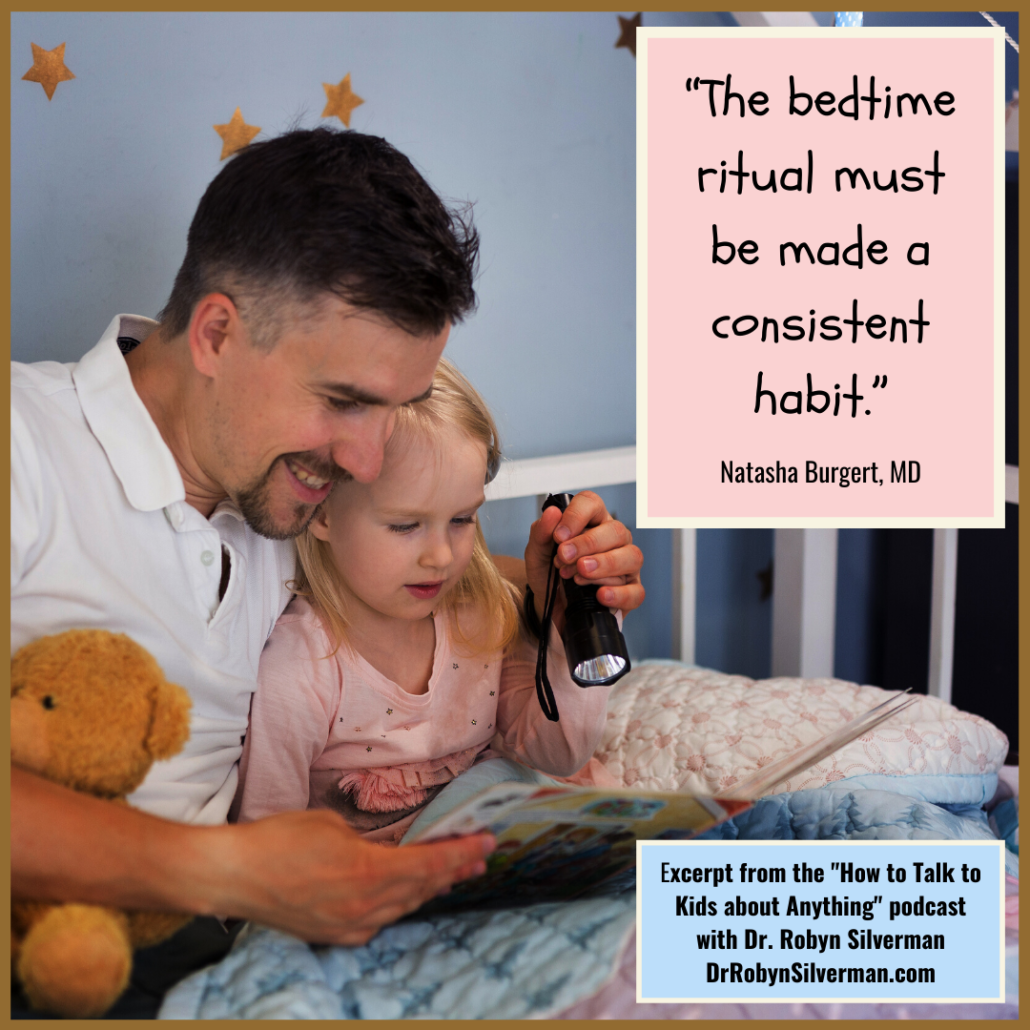Podcast: Play in new window | Download
Subscribe: Apple Podcasts | RSS | More
How to talk to your child through the “bedtime battle” – and win!
This podcast will focus on the most common toddler/early-childhood sleep problems Dr. Natasha Burgert encounters in the office—and how to fix them!
Today we are discussing how to talk your child through the bedtime battle—and win. I know- we all need it! How many parents can say “me too” when they hear a sleepy parent talk about how their child wouldn’t go to sleep or woke up in the middle of the night—many of us have dealt with this, me included. My own daughter has had night terrors, nightmares, and I’m just not tired kind of nights. Perhaps that’s happened to you? It’s not an easy scenario- everyone is tired, sometimes over tired, we, as parents, get stressed as we still have to get the dishes done, we have to finish some work or we just simply want to find a time to relax and unwind after a long day. We clocked out at 8:30 but our kids are still working it. Aren’t we lucky to have someone who can help us deal with this challenge today?
say “me too” when they hear a sleepy parent talk about how their child wouldn’t go to sleep or woke up in the middle of the night—many of us have dealt with this, me included. My own daughter has had night terrors, nightmares, and I’m just not tired kind of nights. Perhaps that’s happened to you? It’s not an easy scenario- everyone is tired, sometimes over tired, we, as parents, get stressed as we still have to get the dishes done, we have to finish some work or we just simply want to find a time to relax and unwind after a long day. We clocked out at 8:30 but our kids are still working it. Aren’t we lucky to have someone who can help us deal with this challenge today?
Dr. Natasha Burgert is a mom, pediatrician, blogger, educator, and National Spokesperson for the American Academy of Pediatrics.
In her full-time suburban private practice, she strives to leverage the traditional values and teachings of medical science within today’s digital health revolution. Her work with patients has been featured in outlets such as The New York Times, The Wall Street Journal and Parents magazine. She has also been highlighted on NBC Nightly News, CBS This Morning, and other local news programs
If she is not in clinic, you can find her on KCKidsDoc.com; as well as Twitter, Facebook, and Instagram. I had the pleasure of being teamed up with Dr. Natasha for an Education Nation’s Parent Toolkit Twitter Chat – she has incredibly helpful tips that we can use right away.
The podcast provides:
- The definition of normal sleep behaviors for toddlers/preschools/school aged kids
- The 5 most common sleep problems
- Action steps to fix each of the 5 most common sleep problems and warning signs that it’s time to see the doctor.
- Tips to prevent many sleep problems in childhood.
- What to say to your child when s/he keeps getting out of bed.
- What you need to know about night terrors, sleep-talking and sleep-walking.
- Some of the biggest mistakes parents make that make the bedtime battle worse.
Important Messages:
- Non-REM sleep: Repair tissues, grow

- REM sleep: Dreaming.
- Toddlers: 11-14 hours sleep per 24 hours. Decrease as kids get older.
- School-age kids- 9-11 hours of sleep. 40 % of childhood!
- Different aged kids have different needs in terms of “sleep architecture.” Have to go through these sleep cycles to get the work of sleep done.
- Common sleep issues: bedtime refusal, won’t stay in bed all night. (behavioral)
- Some bedtime problems are behavioral while others are medical—sometimes the latter are overlooked. Night terrors/sleep walking/sleep talking, restless leg syndrome, sleep apnea.
- Sometimes the best-intentioned parents get in their own way when trying to best cope with the bedtime battle.
- Need to look at the big picture, instead parents are looking at little pieces. Not the right thing to do.
- Patterns from when we were little- like having a snack before bed- not smart to do. Food associated with love but not healthy before bed. Can’t have children eat right before bed. Parents sometimes acquiesce to requests. Reflux from eating right before bed.
- Loving alternative for food before bed. Boundary is needed. Eat an hour or two before bed. Everything relaxes when we sleep. Guts as well! Going to bed on full tummy makes us not feel too good.
- Tell kids the reasons why food before bed is not a good idea.
- Bedtime refusal: All kids unique. Occasion is normal. 1-2 delay between when we put them to bed and when they go to sleep. Bedtime routine- only 30 minutes. What happens at bedtime? Routine- triggered and ready for sleep. Make sure that you shift the sleep phase to a later time for your toddler or preschooler vs your infant. Bath, book, sleep. Consistent. Show by example. Prioritize your child’s bedtime routine so that they know what to expect. Excuses come when routine is inconsistent.
- Technique: Bedtime pass-> Stuffed animal by bed-and handed in when they need one extra hug, bathroom, glass of water. Limit. Get out once but not more than once. Giving control.
- Technique: Excuse me drill-> during bedtime routine, leave for a short while multiple times. Leave and come back. Reassurance. Away longer and longer each day. Then you can remove yourself and not come back. Based on anxiety and separation anxiety.
- When child doesn’t stay in their own bed:
- Decide if this is a problem. Is it disrupting your sleep or your child’s sleep?
- 100 walks. Script: “It’s nighttime, I love you, I’ll see you in the morning.” Walk them back.
- Stay in bed, door can be open. If they get in bed, then 1-minute door is closed. If they are in bed after that, door can stay open. If not, 2 minutes closed.
- Sleeping bag under the bed. Accommodating to the anxiety. Child has some control. But still parenting with boundary.
- Sleep terrors: Appear to be awake but aren’t- in an active phase of sleep. First half of night. Often can predict when it’s going to happen when it’s chronic. When have inadequate sleep, increase sleep walking or terrors.
- 30 minute wake. Knock them out of the sleep cycle. Like if you know terrors have around 11:30, wake at 11 and then knocks them out of sleep cycle and illiminates event.
- If your child wakes up without any recollection of the event, difference between nightmare and night terror.
- Keep cool.
- Sleep apnea: 3-5 % restless leg or sleep apnea. So not behavioral. Sleep Fragmentation. Behavioral problems. Snoring. Learning. Frequent wakings. Sore throat. Wet bed. Flonase. Or take out adenoids. Related to ADHD.
- Restless leg- “I have to get up.” Blood test. Iron.
- SSRI- sleep disruption can happen.
- Melatonin can help.
- Sleep is a discipline.
- The bedtime ritual must be made a consistent habit.
- Establishing a healthy sleep habit can take a long time.
- Have you tried long enough?
- Have you worked through the extinction burst?
- Have you been consistent across caregivers?
- All caregivers must be consistent.
- Bedtime does not start when the lights go out!
- Provide the boundaries while also giving kids some sense of control over sleep.
- There are MANY tips and tools we can use to help win the bedtime battle—and they are provided here in this podcast episode (i.e. 100 walks, immediate rewards, pass tool, excuse me drill, 30-minute wake, etc.)!
- No reason to have electronics in room- negatively effects sleep. Get them out of the room.
Notable Quotables:
- “About 40% of your childhood, you are asleep. That’s how important it is for kids to get these hours!”
- “Everything in our bodies relaxes when we sleep, that includes our insides too! We focus on our eyes and our brain and our body relaxing but remember our guts do too…so if we go to bed on a really full tummy, we’re not going to feel well.”
- “Our kids are unique individuals and they may not be on the same work clock or time clock that we are.”
- “Prioritize your child’s bedtime routine so that they know what to expect.”
- “Sleep is a discipline. Sleep is a habit…it is the hard work of parenting. So if you’ve tried everything have you tried long enough?”
- “The bedtime ritual must be made a consistent habit.”
- “Bedtime does not start at bedtime. You can’t just start thinking about bedtime when it’s time to turn the lights out.”
- “There’s no reason to have TVs or electronics in the kids’ bedrooms. For young kids, school-age kids or teenagers, get them out. You will never be faulted for the quality of sleep you get for ourselves and our kids if we get those electronics out of the room.”









